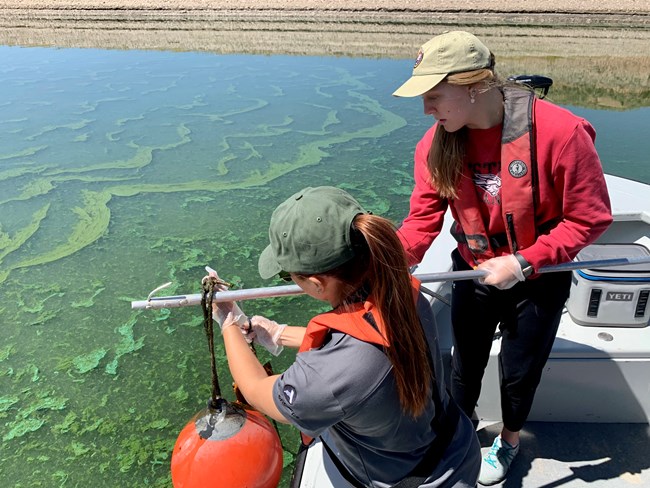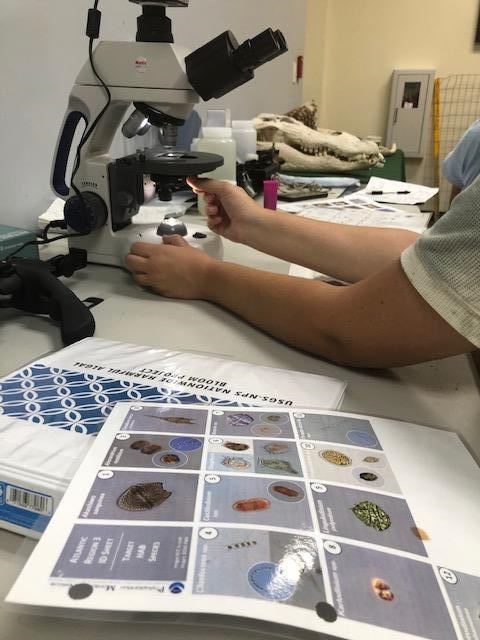Last updated: May 31, 2023
Article
Harmful Algal Blooms: Science to Support Solutions from Shore to Shore
The 11th U.S. Symposium on Harmful Algae, held October 23-28, in Albany, New York, gathered scientists from a range of disciplines and natural resource managers to discuss Harmful Algal Blooms (HABs) and related topics including bloom dynamics, predictive models and forecasting, remote sensing, toxins, and taxonomy of the microorganisms that cause harmful algal blooms.
The symposium was hosted by NEIWPCC, a regional commission that helps Northeastern states preserve and advance water quality, the New York State Department of Environmental Conservation, and the U.S. Geological Survey, with support from the U.S. National Office for Harmful Algal Blooms at the Woods Hole Oceanographic Institution. Within this setting, about 500 attendees discussed progress in understanding algal bloom ecology and the solutions necessary to prevent and reduce HABs.

USGS Photo
As part of the conference, the NPS and USGS hosted a Plenary Panel Discussion called “Harmful Algal Bloom Science and Management in National Parks.” Dr. Jennifer Graham, Dr. Victoria Christensen, and Hayley Olds, USGS, along with Dr. Danielle Buttke, Jamie Kilgo, and Dr. Kerensa King, NPS, convened a panel of park managers, scientists, and partners to share their experiences with HABs in national parks. The session combined in-person and recorded presentations that explored ongoing and recently completed research, collaborative partnerships, and management challenges.
Dr. Jennifer Graham, USGS, moderated the panel and Dr. Kerensa King, NPS, set the stage by detailing the effects HABs events have on park units nationwide, ranging from excess biomass to significant wildlife die-offs. Panelists then shared first-hand accounts about their experiences dealing with HABs in national parks.

NPS Photo / Nicki Gibney
Kelly Nesvacil, NPS, described Padre Island National Seashore’s history of HABs in both marine and freshwater areas. Since 2000, six Red Tide HAB events have affected large swaths of the park’s marine waters. Red Tides commonly cause coyote and bird mortalities, and in some cases, result in mass fish die-offs. The Texas Parks and Wildlife Department leads HAB response coordination, and the park works closely with the state to monitor the blooms and issue advisories.
Similarly, Brown Tide HAB events have led to eelgrass declines and shellfish mortality in the Great South Bay along Fire Island National Seashore. Mike Bilecki, NPS, spoke about the Seashore’s limited capacity to address all the natural resource challenges facing the park and stressed the importance of partnerships with nearby universities and with other agencies for HAB monitoring and research.
While some parks like Padre Island and Fire Island National Seashores have been responding to HABs for many years, others have only recently detected their first HAB. In July 2020, a dog death at Zion National Park tipped off park managers to the presence of benthic algae capable of producing a potent neurotoxin growing in the park’s rivers. Robyn Henderek, NPS, outlined the park’s response to the newly detected benthic blooms; they used a multiple lines of evidence approach with complimentary monitoring methods to determine when to issue recreational advisories for visitors. Dr. Hannah Bonner, State of Utah, further highlighted the widespread concern for benthic HABs in highly recreated waters of Utah. Benthic algal species capable of producing toxins have been found in five Utah national parks and a changing climate may favor these species.

NPS photo
Interdisciplinary collaborations with Federal and State agencies, universities, Tribes, and grass-roots organizations enable the diverse range of research and monitoring being conducted to better understand HABs.
St. Croix National Scenic Riverway partnered with the Wild Rivers Conservancy and USGS to develop a HAB citizen monitoring program called the Algae Alert Network. Marian Shaffer, NPS, said the program is a huge success and benefits both the volunteers who learn more about stewardship of the river and NPS who gains data about HABs along the length of the riverway.
The USGS-NPS Water Quality Partnership Program supports critical water-quality research in national parks. Numerous ongoing studies funded by the partnership focus on HAB drivers and impacts in parks. Hayley Olds, USGS, and Jamie Kilgo, NPS, presented on a nationwide study that aims to understand algal toxin occurrence in 21 parks and to develop tools and strategies that parks can use to monitor, assess, and mitigate the effects of HABs in their freshwater and marine resources.
Dr. Victoria Christensen, USGS, spoke about a long-term partnership between USGS and Voyageurs National Park to study HABs and collect consistent datasets. Her research indicates that water levels, which are controlled by an international agreement between the USA and Canada, are an important factor in eutrophication and thus in bloom development.
Dr. Jennifer Graham, USGS, ended the session describing a cautionary tale from Dr. Danielle Buttke, NPS. In 2021, several bison died in Tallgrass Prairie National Preserve and HABs were immediately tapped as a potential cause of the deaths. Graham said that only a few years ago, HABs were not on the forefront of managers’ minds when dealing with wildlife health issues and likely would not have been considered as cause of the bison deaths. And while HABs and the toxins they can produce are a concern for wildlife health, in this case, the cause of death was determined to be caused by bacteria. As HAB impacts become better known by resource managers, this story underscores the importance of investigating wildlife health issues thoroughly and not jumping to conclusions.
Strong partnerships that support HAB monitoring, response, and mitigation were a fundamental theme throughout the panel discussion. Parks face a myriad of challenges from HABs and they cannot address them all alone. NPS and USGS look forward to continuing to work with our partners.
